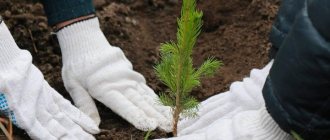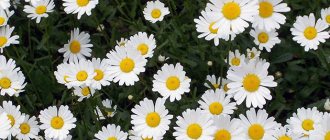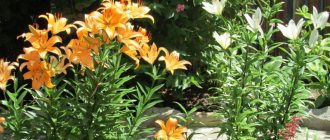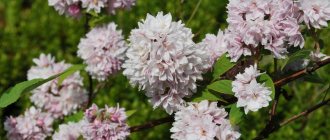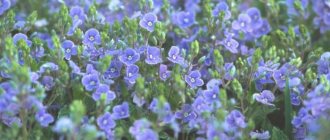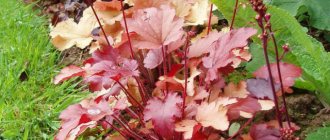Nerine or nerina is a capricious and beautiful nymph brought to Europe from tropical latitudes. It is a decorative flowering bulbous perennial that grows in the wild of the South African tropics. Nerine is suitable for planting in open ground conditions in regions with harsh winters only if it is provided with a warm wintering indoors. It can be grown at home or as a tub plant, which in the warm season is taken out into the garden and buried on the site. For its bizarre flowers with thin wavy petals, nerine received the name “spider lily,” although some other types of lilies that are not related to this genus have the same name.
General description with photo
Nerine is a member of the Amaryliaceae family, native to tropical regions of the equatorial belt. The leaf rosette is low, located at the very base of the bush. A characteristic feature of the plant is that after a period of dormancy, a tall peduncle with amazing thin-petalled lilies is first thrown out of the bulb, and already at the height of flowering, narrow and pointed leaves begin to grow, however, the timing may shift depending on the variety. The root system is represented by a bulb, which, as it grows, begins to protrude more and more from the ground, and always rises above the ground level. The peduncle itself is bare, leafless, reaching half a meter in length in particularly developed specimens.
At its top, up to 12 (and in some species up to 20) lily-shaped flowers bloom. The petals are very thin, long, curved, wavy, which is why the appearance of the flower resembles a spider with long legs. The color of the inflorescences can vary from white and pink to dark purple, and can also be orange or red, sometimes with differently colored stripes. At home, the peduncle and foliage most often grow simultaneously.
Flowering of all types of nerine usually occurs in the fall, at the beginning of the season, and lasts for 2 months.
Types and varieties of nerine
Nerine (nerina) belongs to the Amaryllidaceae family (other representatives of the genus: wallota, hippeastrum, amaryllis, clivia, hemanthus). The genus itself includes about 30 species. A significant part of the species blooms in summer, and only four in winter. The most famous are Nerine sarniensis and Nerine bowdenii, which are widely used in breeding, especially in the Netherlands.
We most often sell Nerine Bowden bulbs - this is the late-flowering species of the Amaryllis family and the most cold-resistant species of the genus, can withstand temperatures down to -15 °C. Its bulbs were first brought to Europe in 1903 by Cornish Bowden, after whom the species was named.
Bowden's nerine and another species, Nerine undulata, are grown as horticultural crops in Britain. In our region, nerine is grown exclusively as potted crops.
It is rare to find Nerine sarniensis on sale here. Its flowers are more diverse: hybrids and varieties of Wolsey (bright scarlet flowers), Rushmere Star (bright pink), Cynthia Chance (orange), Blanchefleur (white) are common in cultivation.
The photo shows Nerine sarniensis.
Another promising species is Nerine undulata. The species is quite easy to cultivate and is definitely of great interest for wider cultivation. It blooms just 2 years after sowing.
In the photo, wavy nerine (Nerine undulata)
Varieties of nerine with photos
About three dozen basic varieties of perennials have been described. Those of them that are grown in European culture do not have fundamental differences in terms of care or heat-loving behavior.
Nerine Bowden
A South African plant with 5-centimeter mature bulbs, covered on the outside with shiny dry brownish scales. Elongated leaves grow from the sheath, which simultaneously forms a tall false stem-peduncle. Closer to the top, the leaves are slightly narrowed and have an unpronounced groove along the entire length. With a length of 30 cm, their width is no more than 2.5 cm. The leaf blade is smooth, veined. The tall peduncle produces one bracted leaf, which gradually turns pink as it blooms. Each inflorescence bears 10-12 pink buds with a darker contrasting stripe.
Nerine winding
Also grown indoors, but quite rare, with a bulb not exceeding 4 cm in diameter. The peduncle is very tall. In nature, it can reach 90 cm. Simultaneously with the opening buds of pale pink or white color, up to seven narrow and long leaves appear simultaneously from the bulb. The flowers are bell-shaped.
Nerine flexifolia
The bulb is larger, up to 6 cm, ovoid in shape. It is distinguished from other varieties by a more voluminous leaf rosette with an increased number of leaves. They can reach half a meter in length. The inflorescence is painted in a scarlet tone. The petals are long, shiny, twisted, with long stamens located in the center of the corolla.
Nerine sarney
The homeland of the species is the Cape Province of the South African continent. Often grown as a houseplant. The bulb is medium in size, elongated in shape. The leaf blades are almost straight, no more than 30 cm. The forcing of leaves is late; they begin to grow almost after flowering has ended. The inflorescence is multi-colored, up to 20 buds of rich cherry color can bloom on one specimen, their size is smaller than that of other varieties. There are three most popular varieties of this variety.
- Sarney Corusca. The inflorescences are large, scarlet, elongated leaves are marked with a dark stripe in the center.
- Plantini Baker. It has a peduncle longer than usual, blooms in red-brown or cherry color, the petals are long and needle-shaped.
- Venasta Baker. An early flowering variety with medium-sized flowers. The petals are slightly curved and crescent-shaped.
Nerine low
Another variety suitable for growing as an indoor flower at home. Peduncles are no higher than 30 cm, the foliage is dark in color, appears from the bulb and begins to grow from the very beginning of flowering. The flowers are medium-sized, numerous, their color can be pale pink or red. Petals are wavy and wrinkled.
Important! All parts of nerine are poisonous and pose a danger to humans and animals.
When working with the plant, it is necessary to provide the necessary protection and work with gloves. The flower should be placed in a place inaccessible to children and pets.
Main types
Nerine bowdenii
This species is native to South Africa. The length of the bulbs is about 50 millimeters, with most of them rising above the ground surface. Dry outer scales are glossy and brownish in color. Long leaf sheaths form a false stem, which reaches a height of 50 mm. Linear leaf plates, tapering towards the apex, are slightly grooved, their length is about 0.3 m and their width is 25 mm. The surface of the glossy leaves is completely covered with veins. The length of the peduncle is about 0.45 m, and there is an umbrella-shaped inflorescence on it. There is no foliage on the peduncle. On the inflorescence there is a bracted leaf; over time it turns pink. The inflorescence contains about 12 flowers. On the surface of the curled pink perianth leaves there is a stripe of darker color. This species blooms in mid-autumn.
Nerine flexuosa
This species is relatively rare. On long peduncles there are inflorescences consisting of flowers similar in shape to bells; wavy petals can be painted pink or white. This species blooms in autumn.
Nerine curvifolia
Linear-lanceolate leaf blades reach their maximum length only after the plant has flowered. The length of the peduncle is about 0.4 m. The umbrella-shaped inflorescences include about 12 flowers similar to lilies. The flowers have glossy red petals and long stamens.
Planting, propagation
Nerine can be propagated in two ways - by seed and with the help of bulbs. Cultivation in open ground is possible, but with the obligatory transfer of the bulbs indoors for the winter. Wintering in open ground for nerine is possible only in the southern regions, for example, on the Black Sea coast of the Caucasus.
Seed method of growing nerine
The method is troublesome, time-consuming and requires some experience, so it can hardly be recommended to inexperienced gardeners. Seeds are sown in a mixture of sand and vermiculite with embedding in the ground or surface, followed by arrangement of a mini-greenhouse. The optimal temperature for the period of seed germination is about +22C. With the appearance of the first seedlings, the film is removed and the temperature is lowered by about 2-4 degrees. As soon as the sprouts become stronger, they need to be transferred to a soil mixture recommended for growing adult specimens.
Growing from a bulb
An easier and faster way. Young bulbs are laid out vertically in a bowl half filled with soil and sprinkled so that some of the bulbs remain exposed to the air. The soil mixture is moistened once during planting, after which watering is no longer done until the first shoots appear from the bulbous sheath.
When planted by seeds, the first dormant phase begins only in the third year of the flower’s life; when propagated by bulbs, the plant goes into hibernation in the first year.
Growing Nerine from Seeds
Nerine seeds photo
Nerine is propagated by seed and daughter bulbs.
Seeds must be sown immediately after ripening. Use boxes or bowls filled with nutritious soil. The seeds are distributed over the surface of the soil and are not buried in the ground. The distance between the seeds is 2-3 cm. Spray the crops with a spray bottle. Vermiculite can be used as soil. Cover the crops with film and germinate at an air temperature of at least 22° C.
Nerine from seeds photo shoots
Expect germination in a couple of weeks. When 2-3 leaves appear, plant them in separate containers. Nerines obtained from seeds must be grown for 3 years without a dormant period.
Nerine transplant
In the absence of an emergency (illness, fall, etc.), a planned transplant is carried out after 4-5 years. Due to the special life cycle of nerina, it should be done not in the spring, as usual, at the end of summer, by the time the plant is ready to emerge from dormancy. It is recommended to use ready-made soil for decorative flowering indoor crops. If it is compiled manually, then preference should be given to a sand-humus mixture with the addition of turf soil. A drainage layer must be provided at the bottom of the pot.
Caring for Nerine at home
The agricultural technology of heat-loving exotic plants is dictated by the conditions of its natural growth and the characteristics of the alternation of life cycles, which are different from most bulbous plants. After flowering ends, the flower does not immediately go into hibernation; its leaves continue to grow, and sometimes only at this time they just begin to develop. This continues until spring, when it becomes noticeable that the nerine is about to plunge into a dormant phase. By the end of spring, the leaves die off and the bulb goes into a sleep that lasts until the end of summer. From this moment, you need to take measures to ensure the bulb is fully rested, stop watering it, feeding it and lower the temperature. If possible, it is better to place the pot in a cool and dark, but not damp place. Ideally, the temperature for this period should be within +8...+10C. In summer, such conditions can be provided in the cellar. In winter, the plant needs more light than the weakly active sun at this time of year can provide, so you will need to take care of additional lighting.
A sign that the bulb is awakening is a change in its color; it will begin to acquire a bronze tint.
Watering
It is necessary to water the nerine quite often, but moderately, since the bulb during the period of active growth consumes quite a lot of moisture, but at the same time, it rots very easily if it grows in constantly wet soil. The maximum amount of moisture consumed occurs at the beginning of autumn, during the period of forcing the peduncle. The correctness of watering will be indicated by the condition of the leaves (if they are present at the moment). Yellowing and drying of leaves outside the rest season means that the watering regime is not being followed correctly. Moreover, this does not necessarily indicate a lack of moisture, since its excess content in the soil can lead to exactly the same consequences.
By the beginning of spring, watering should become more rare and meager, and then it can be stopped until the end of August.
It is advisable to replace the top layer of soil by the beginning of the new growing season. But you can’t cover the bulb “head over heels” with soil!
Feeding
Complex mineral compositions of universal use for indoor flowering crops are used as fertilizers. During the budding period, fertilizing is done every 2-3 weeks; in winter, a single application every month is enough, after which fertilizers are not required at all and will even be harmful.
Air humidity
With all the love of the “spider lily” for light soil moisture, the air for growing nerine at home should be dry. There is no need to place any water trays or other humidifiers next to it.
The transition to the active state must be accompanied by a gradual change in conditions. You cannot take a pot with a bulb ready to awaken from the basement and immediately place it on the window. There should be a gradual increase in temperature and an increase in watering.
If the nerine overwintered at too high a temperature, it may not flower, and this is the best case scenario. Sometimes it can bloom prematurely and die immediately after.
Features of care
Nerine is a lover of liquid fertilizers. Feeding should be done once every week during flowering, when it ends (by the middle of the spring period) - once every two weeks is enough. May is the time to stop feeding until the bush blooms again.
From this month until the first days of August, the plant needs a certain environment: peace, lack of fertilizers and warmth (25°). This is followed by a new forcing of nerine, the planting and care of which requires special diligence.
When the necks of the awakened bulbs are covered with a bronze-tinged coating, they are placed in a fresh soil mixture containing old clay, sand and compost or humus in equal parts (you can add bone meal).
To prevent the substrate from being highly acidic, it is flavored with chalk, and it must also contain horn shavings, superphosphate (25 g per ten liters) and potassium sulfate (8 g). It is important not to forget about regular watering.
In a pot with a diameter of up to 13 cm, you can place 1-2 onions with their heads not buried. (In a larger container their development is inhibited.) It will take about a month for the flower stalks and buds to appear. But with an illiterate approach to rooting, the buds are unlikely to open.
This plant can be propagated using seeds. Ripe seeds are sown immediately. They are grown in bowls - in a substrate with vermiculite and sand. For sowing, maintain a temperature of 21-23°.
In a couple of weeks, the time will come for the first seedlings, which are then planted in separate pots with soil mixture. (Its composition was described just above). Now the plants require coolness of 16-18° and bright diffused light, but young flowers do not need a dormant period of three years.
Nerine requires careful care, because the plant contains poison. Therefore, after completing all work, hands must be washed thoroughly with soap.
Diseases and harmful insects
Watering the planted bulbs (at the end of the dormant period) should be careful to prevent them from rotting.
Despite the high resistance of the flower to insects, aphids occasionally appear on it. But modern means successfully combat it.
Main types
The most beautiful and spectacular indoor flowers are the genus Nerine (the photos indicate this fact). It includes approximately 30 species of this plant. Nerine Bowden is considered the most popular due to its hardiness and variety of varieties.
However, in order to “tame” Bowden’s nerine, planting must be carried out according to strict rules: good drainage, fertile soil, preferably 1 bulb in a pot, abundant watering, special temperature conditions, humidity, mandatory fertilizing.
To grow an exotic nerine flower at home, planting and caring for it must meet certain requirements, because this plant is capricious and loves care. But the interior will become bright and unusual, filled with beauty and grace.
Also
Diseases and pests
Viral diseases practically do not affect this flowering perennial, but it often suffers from errors in care. In addition, nerine is susceptible to attack by mealybugs. These are tiny whitish pests that feed on the vital juices of plants. A sign of damage is the appearance of traces of black mold on the leaf blades, however, this stage is already considered advanced. Before treating with an insecticidal preparation, you must manually wipe the leaves of the plant with a damp sponge or paper towel lightly soaped with laundry soap.
In addition to the mealybug, the nerine flower can be favored by aphids, especially in garden conditions. The lesion tends to spread rapidly and requires surgical intervention. In the initial stage, you can get by with using a soap solution, but if a lot of aphids are found, spraying with chemical compounds is recommended.
Leaves of the plant that are beginning to wilt should not be removed. It is necessary to wait until they fall off on their own, since until this moment they are still giving their vitality to the bulb to nourish it during rest.
